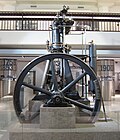Diesel engine
Diesel engine is a type of internal combustion engine invented by Rudolf Diesel. Diesel engines are known for their high efficiency and power. They are commonly used in heavy-duty vehicles such as trucks, buses, and construction equipment.
History[edit]
The diesel engine was invented by Rudolf Diesel in 1892. He was a German engineer who was interested in creating an engine that was more efficient than the steam engine. Diesel's engine used the heat of compression to ignite the fuel, which made it more efficient than other types of engines at the time.
Design and operation[edit]
Diesel engines operate by drawing air into the cylinder, compressing it, and then injecting fuel into the compressed air. The heat of the compressed air ignites the fuel, causing it to burn and push the piston down. This is known as the diesel cycle.
Diesel engines are designed to operate at high compression ratios, which makes them more efficient than gasoline engines. However, this also makes them heavier and more expensive to build.
Applications[edit]
Diesel engines are used in a wide variety of applications, including:
- Transportation: Diesel engines are commonly used in trucks, buses, and other heavy-duty vehicles. They are also used in some passenger cars, although this is less common.
- Construction: Many types of construction equipment, such as bulldozers and excavators, are powered by diesel engines.
- Power generation: Diesel engines are often used in generators to produce electricity, especially in remote or off-grid locations.
- Marine: Many ships and boats use diesel engines for propulsion.
Environmental impact[edit]
Diesel engines emit a variety of pollutants, including particulate matter and nitrogen oxides. These pollutants can have negative impacts on air quality and human health. However, modern diesel engines are equipped with emission control systems that can significantly reduce these emissions.
See also[edit]
|
|
|
Diesel engine gallery[edit]
-
Dieselmotor Langen & Wolf, 1898
-
Lumbar patent diesel engine
-
Experimental Diesel Engine
-
Historical Diesel engine in Deutsches Museum
-
Dieselmotor vs
-
Fairbanks Morse model 32
-
ZT 303 Motor
-
OM 352
-
Neckarsulm AudiForum Audi R10 TDI
Ad. Transform your life with W8MD's Budget GLP-1 injections from $75


W8MD offers a medical weight loss program to lose weight in Philadelphia. Our physician-supervised medical weight loss provides:
- Weight loss injections in NYC (generic and brand names):
- Zepbound / Mounjaro, Wegovy / Ozempic, Saxenda
- Most insurances accepted or discounted self-pay rates. We will obtain insurance prior authorizations if needed.
- Generic GLP1 weight loss injections from $75 for the starting dose.
- Also offer prescription weight loss medications including Phentermine, Qsymia, Diethylpropion, Contrave etc.
NYC weight loss doctor appointmentsNYC weight loss doctor appointments
Start your NYC weight loss journey today at our NYC medical weight loss and Philadelphia medical weight loss clinics.
- Call 718-946-5500 to lose weight in NYC or for medical weight loss in Philadelphia 215-676-2334.
- Tags:NYC medical weight loss, Philadelphia lose weight Zepbound NYC, Budget GLP1 weight loss injections, Wegovy Philadelphia, Wegovy NYC, Philadelphia medical weight loss, Brookly weight loss and Wegovy NYC
|
WikiMD's Wellness Encyclopedia |
| Let Food Be Thy Medicine Medicine Thy Food - Hippocrates |
Medical Disclaimer: WikiMD is not a substitute for professional medical advice. The information on WikiMD is provided as an information resource only, may be incorrect, outdated or misleading, and is not to be used or relied on for any diagnostic or treatment purposes. Please consult your health care provider before making any healthcare decisions or for guidance about a specific medical condition. WikiMD expressly disclaims responsibility, and shall have no liability, for any damages, loss, injury, or liability whatsoever suffered as a result of your reliance on the information contained in this site. By visiting this site you agree to the foregoing terms and conditions, which may from time to time be changed or supplemented by WikiMD. If you do not agree to the foregoing terms and conditions, you should not enter or use this site. See full disclaimer.
Credits:Most images are courtesy of Wikimedia commons, and templates, categories Wikipedia, licensed under CC BY SA or similar.
Translate this page: - East Asian
中文,
日本,
한국어,
South Asian
हिन्दी,
தமிழ்,
తెలుగు,
Urdu,
ಕನ್ನಡ,
Southeast Asian
Indonesian,
Vietnamese,
Thai,
မြန်မာဘာသာ,
বাংলা
European
español,
Deutsch,
français,
Greek,
português do Brasil,
polski,
română,
русский,
Nederlands,
norsk,
svenska,
suomi,
Italian
Middle Eastern & African
عربى,
Turkish,
Persian,
Hebrew,
Afrikaans,
isiZulu,
Kiswahili,
Other
Bulgarian,
Hungarian,
Czech,
Swedish,
മലയാളം,
मराठी,
ਪੰਜਾਬੀ,
ગુજરાતી,
Portuguese,
Ukrainian










